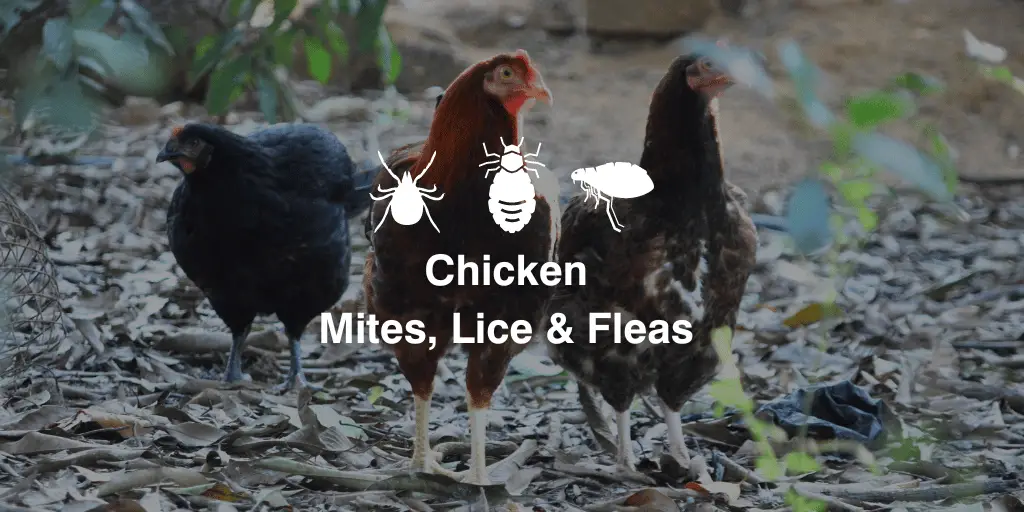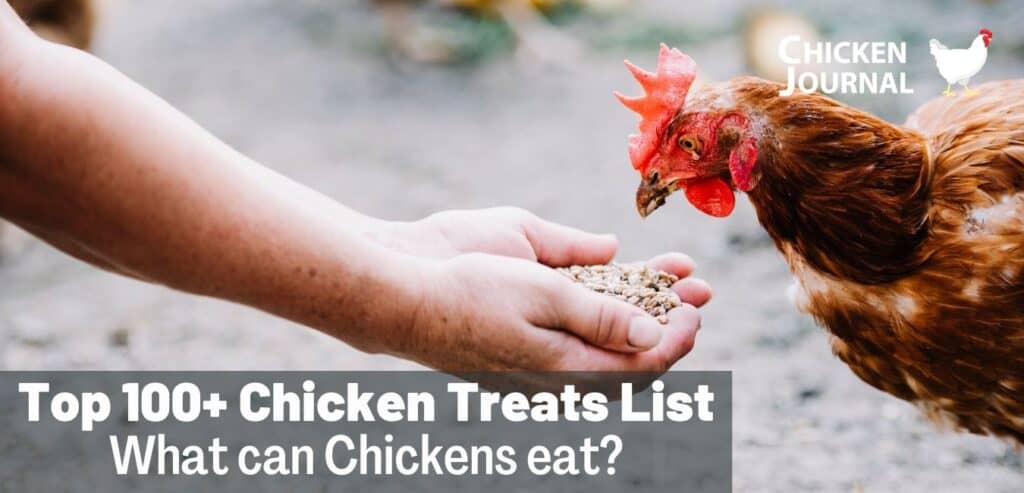Chicken mites, lice, and fleas are common parasites that can infest poultry and cause discomfort and health issues.
This comprehensive guide will give poultry farmers the knowledge they need to identify, treat, and prevent mites, lice, and flea infestations in their flocks.
Also read: Best deworming medicines for chickens
Chickens are lovely birds, and they are the same as other pets. That’s why they also get infested with pests.
Like other pets and poultry birds, chickens can be infested with various parasites. The most common parasites are mites, lice, and fleas.
Chickens are foragers, so they move into various parts of your backyard and garden, where they get infested with these parasites.
Let’s differentiate these top 3 parasites, which are very dangerous for chicken’s health if not diagnosed and treated on time.
Chicken Mites
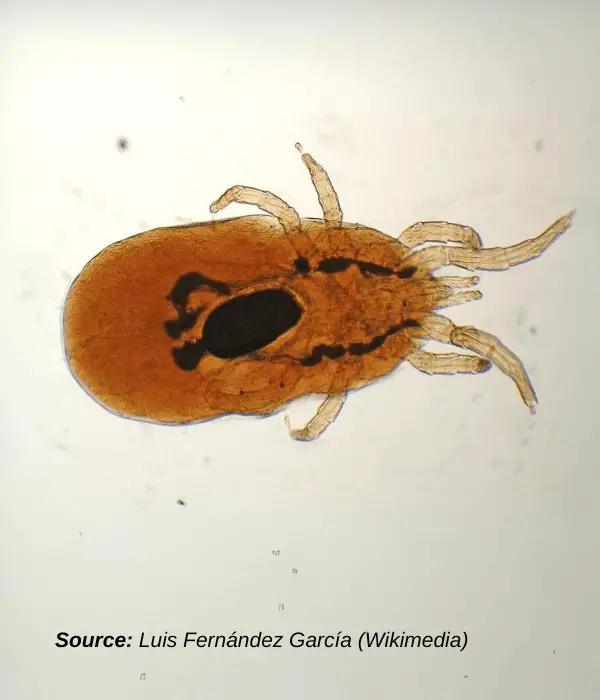
Mites are tiny arachnids that infest chickens as well as mammals and humans. But they are different in sizes and types according to the animal.
They cause different types of health issues if not treated on time. Several chicken mites are available, like Northern fowl mites, the Red poultry mites (also known as the chicken mites), and the Scaly leg mites.
Mites mainly feed on the blood, skin, or keratin of chickens. This causes irritation, feather loss, decreased egg production, and, in severe cases, anemia and death.
The main problem with chicken mites is that they can live for a long time in chicken coops and run for a long time without a host.
After waiting for a long time, when they get a new flock as a host, they infest it. That is why it’s essential to keep an eye on them; if they increase in number, controlling them is very hard.
Chicken Lice

Lice in chickens are small insects without wings that feed on dead skin, feather debris, and other organic matter on the bird’s body. Menacanthus is the most popular chewing louse in chickens.
They are a little different from mites because they can live long without a host. They survive only with a host. Not only that but they can also be spread from chickens to humans.
Lice infestation causes high itching and discomfort, causing restlessness, feather pecking, and skin damage.
You can see symptoms like weight loss, stress, and reduced egg production in chickens with chronic lice infestation.
Chicken Fleas

Fleas are not always seen in poultry farms, whereas lice and mites are the most common parasites.
The Sticktight flea (Echidnophaga gallinacea) infests poultry birds. They jump a very far distance from one host to another.
They mostly suck blood from the open skin around the face, comb, wattles, and other featherless parts.
When the infestation becomes chronic, you can see symptoms like irritation, redness on the attached spots, anemia, and blindness if infected around the eyes.
Importance of Recognizing and Treating Infestations Early
It is crucial to avoid any type of infestation by mites, lice, and fleas. Regular inspection and visiting the coop in a regular manner help you find the issue.
Still, after regular inspection, chickens can be infested by poultry parasites, but in the initial stage of infestation, mites, lice, and fleas are easy to get rid of.
Late recognition may lead to major health issues in flocks and can make them weak and reduce egg-production. So, early intervention helps people to live happily and pest-free.
Chart Showing Differences in Chicken Mites, Lice, and Fleas
| Aspect | Chicken Mites | Chicken Lice | Fleas |
| Classification | Arachnids | Insects | Insects |
| Size | Very small | Tiny | Varies, generally small |
| Wings | Wingless | Wingless | Winged (but cannot fly) |
| Feeding Habit | Blood feeders | Feed on dead skin, blood, and feather debris | Blood feeders |
| Location on Host | Feathers and skin, can survive in coop environment | Remain on host throughout lifecycle | Attach to featherless areas of the bird (e.g., around eyes, under wings, near vent) |
| Life Cycle | Egg, nymph, adult stages; can survive without host | Egg, nymph, adult stages; complete lifecycle on host | Egg, larva, pupa, adult; can jump to and from host and environment |
| Visibility | Closer inspection needed; may be visible at night | Closer inspection needed | Visible to naked eye due to jumping behavior |
| Impact | Restlessness, reduced egg production, feather peeling | Excessive preening, irritated skin, feather damage | Clusters of dark spots around featherless areas, irritation, potential anemia |
| Transmissibility | Direct contact with infested birds or wildlife, infested environment | Direct contact with infested birds or environment | Direct contact with infested birds or environment |
| Preferred Habitat | Feathered areas, coop environment | On host | Featherless areas of the bird, environment |
| Hygiene Impact | Poor coop hygiene can attract and foster infestations | Poor hygiene facilitates infestation | Poor hygiene facilitates infestation |
| Health Implications | Feather loss, skin irritation, anemia, decreased egg production | Feather damage, irritated skin, potential anemia | Irritation, potential anemia, decreased productivity |
| Behavioral Changes | Restlessness, decreased foraging and social interaction | Excessive preening, discomfort | Restlessness, irritation |
Signs, Symptoms, Diagnosing Mites, Lice, and Fleas in Chickens
Identifying and diagnosing mites, lice, and fleas infestation on hens requires in-depth knowledge of their symptoms and how to check for infestations properly.
We’ll explain how to understand the signs, symptoms, and diagnosis of these nasty parasites.
What do Chicken Mites, Lice, and Fleas Look Like?
Red or black chicken mites are small and hard to spot without magnification. After eating or sucking blood, they may turn red. They are most active at night, so you may not spot them on your hens during the day but in coop crevices.
Chicken lice are bigger than mites and generally brown or yellow. We can see them moving fast around the vent, under the wings, and at the base of the feather shafts.
Sticktight fleas in chickens show small, black dots on the head, neck, and wings. They irritate the skin noticeably when they burrow into it.
Symptoms of Chicken Mites, Lice, and Fleas Infestation
A decrease in egg production, irritability or restlessness, feather pecking or plucking, and pale combs or wattles due to anemia are common symptoms of mite infestation. Scaly leg mites are found on the legs, causing rough and scaly skin.
Lice symptoms include excessive preening or scratching and damage or loss of feathers, particularly in the area surrounding the vent. Loss of weight and growth retardation (in more severe instances) are common signs of lice infestation.
Severe irritation, red skin regions, patches where fleas suck and stick. You can also see symptoms like swelling around the head and neck. In chronic conditions, anemia is commonly seen showing pale combs and wattles.
How to Check Chickens for Mites, Lice, and Fleas?
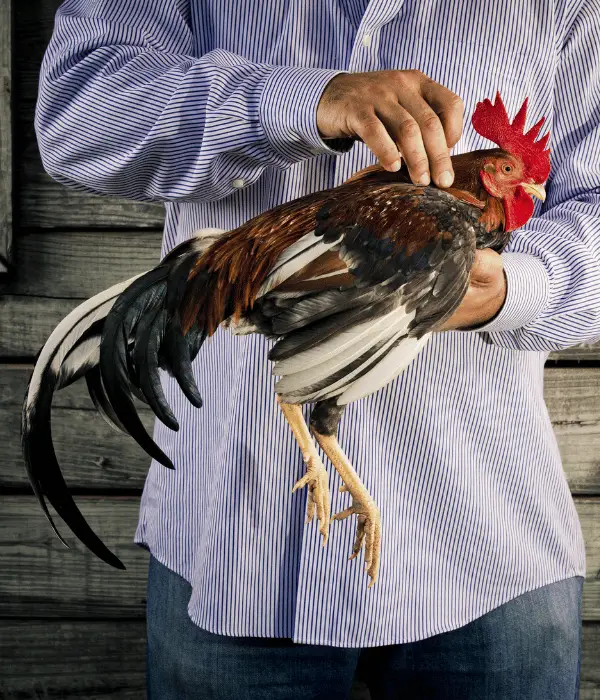
Regular Inspection
Do regular health checks for each bird, ideally once every few weeks or once a month. This is the first step in the regular inspection process. Because pests are more active during the warmer months, you should pay special attention to them.
Physical Examination
Holding the chicken securely is necessary to induce a state of calm. Wrapping it in a towel could be helpful.
Check Feather Areas
Examine the base of the feathers, the area under the wings, the area surrounding the vent, and the area on the neck in great detail. If you want a better look, you should use a magnifying glass or a flashlight.
Check the Skin:
Take a look for any indications of discomfort, such as redness, lumps, or the movement of real bugs.
Examination of the Legs:
In particular, while looking for mites such as the Scaly leg mite, it is important to examine the legs for any crusty or atypical growths.
Check Coop and Run Environment:
Check the coop for indications of pests, paying particular attention to crevices and dark areas. This is the third step in the environmental check. During the day, mites, for instance, are able to conceal themselves in the wood.
Night Inspection:
Mites are more active at night, so a flashlight check of your hens and the locations where they roost after dark might show their existence. Mites are more likely to be found in the nighttime hours.
Check for Nits (Lice Eggs):
Always check the vent, wings, and neck feathers of your hens for lice eggs (nits). Check nest boxes, roosting bars, coop walls, crevices, feather waste, and floor litter for these little, oval-shaped eggs.
Use a magnifying glass or powerful spotlight to find them. To control lice and safeguard your flock, you must examine and clean the coop regularly.
Treatment Methods For Mites, Lice, and Fleas Infestation
This is a rundown of the many treatment methods available for each pest:
Chicken Mites Treatment:
- OMRI Listed for organic gardening
- Easy-to-mix liquid concentrate
- Biological insecticide
- Item Package Dimensions: 1.75" L x 3.5" W x 6.25" H
Last update on 2025-06-30 / Affiliate links / Images from Amazon Product Advertising API
Commercial sprays: Elector PSP (Spinosad) and other similar products are among the most common options.
In addition to eggs, they target all phases of the mite life cycle. It is important to carefully follow the application instructions, which often include combining a certain quantity with water and spraying it directly on the birds and the coop (after the bedding has been removed).
In order to eliminate freshly hatched mites, it is necessary to provide treatments at the required intervals, which typically range from seven to ten days.
- OMRI Listed - Listed with the Organic Minerals Research...
- Natural Product - Composed of 10lbs of 100% ground...
- Vegan-Keto-Gluten Free
- Diatomaceous Earth is a natural source of freshwater...
Last update on 2025-06-30 / Affiliate links / Images from Amazon Product Advertising API
DE Powder: Diatomaceous Earth (DE) is a natural powder that is utilized for the purpose of dehydrating insects. It is composed of fossilized algae.
It is possible to sprinkle DE on hens, coop bedding, and nesting boxes, but its effectiveness is lower than that of sprays.
If you want to avoid breathing in the dust, choose DE which is edible. Because DE loses its potency when it becomes wet, it should be reapplied often.
Chicken Lice Treatment:
- Ready to use
- Reliable fly control on horses, cattle, Sheep, goats &...
- Also for fleas, lice, bedbugs
Last update on 2025-06-30 / Affiliate links / Images from Amazon Product Advertising API
Permethrin Spray and Powders: There are a number of dusts that may be purchased, and some of them contain substances such as sulfur or pyrethrin.
Using a container that contains the product and gently shaking it for a few seconds, dust individual birds by placing them in the container.
For your own protection, put on a mask and gloves. To stop the life cycle of lice, treatments should be repeated at intervals of seven to ten days.
Please be advised that certain strains of lice may develop resistance to the dust that is being used regularly.
- POWERFUL CRAWLING INSECT KILLER : Effectively kills a...
- 100% DIATOMACEOUS EARTH WITH NO ADDITIVES : Made from...
- KILLS INSECTS MECHANICALLY, NOT CHEMICALLY : Works by...
- EASY APPLICATION WITH INCLUDED POWDER DUSTER : Comes...
- LONG-LASTING INDOOR & OUTDOOR PROTECTION : Remains...
Last update on 2025-06-30 / Affiliate links / Images from Amazon Product Advertising API
Powdered Natural Ingredients: Products such as Lice Away mix natural ingredients such as neem oil and diatomaceous earth to create a powder.
These treatments provide a safer choice for organic flocks, despite the fact that they are not as effective as chemical treatments.
Apply in a manner similar to dust, concentrating on regions where lice are most likely to be found (around the vent, wings, and head).
Chicken Fleas Treatment:
When opposed to mites and lice, fleas are far less frequent in hens. This is an important point to keep in mind.
However, if you have found that your chicken is infested with fleas, you can treat them using treatments that are used for lice, diatomaceous earth, and permethrin.
Cleanup of the Coop: This step is essential for all infestations! Regardless of the treatment technique used, the coop has to be properly cleaned to get rid of mites, lice, and flea eggs.
Coop bedding management: Take out all the bedding and nesting material, and then throw it away safely. The surfaces should be scrubbed with hot, soapy water, and then disinfected using a bleach solution that has been diluted with water (1 part bleach to 10 parts water).
Before adding new bedding, make sure the coop has had sufficient time to dry thoroughly.
How to Prevent Mites, Lice, and Fleas in Chickens?
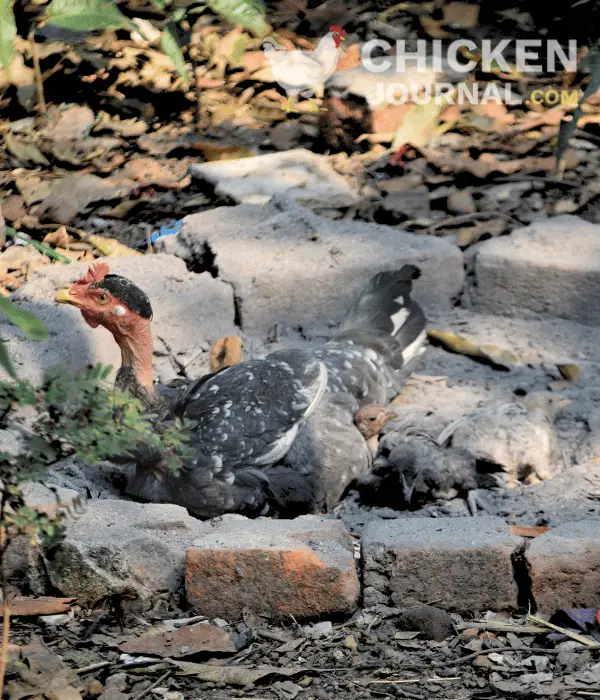
To ensure that your flock lives healthy and productively, it is essential to take measures to prevent mites, lice, and fleas from inhabiting your hens.
The danger of infestation can be greatly reduced by implementing effective prevention measures.
Regular Cleaning: Maintain the cleanliness of the coop by cleaning and disinfecting it on a regular basis in order to get rid of parasites and the eggs they lay. Ensure that the bedding is dry and does not provide an environment that is conducive to the invasion of pests.
Provide Dust Baths: Chickens have a natural tendency to dust bathe in order to drive away pests. Make certain that they have access to a dust bath area that is stocked with sand, diatomaceous earth, or a poultry dusting powder that has been specifically created for chickens.
It is important to monitor and quarantine any new birds that you add to your flock. Before introducing them to your existing birds, you should first isolate them and keep an eye out for any symptoms of infectious diseases.
Utilize Herbs That Are Effective in Repelling Pests: Including pest-repellent nesting herbs in your chicken coop and nesting boxes, such as lavender, mint, and rosemary, can be an effective way to organically combat pests.
Pests that flourish in wet and unclean environments are less likely to be attracted to environmental conditions that are clean and dry.
Conclusion
It is most important to remove mites, lice, and fleas from the chicken coop. Once they spread, they can become a major health issue in poultry farms.
These parasites suck chickens’ blood, make them sick, reduce egg production, reduce weight, and show various other health problems.
Early detection helps you to get rid of these pests quickly. You just need to apply a few lotions or liquids, as your vet advises.
Fast treatment will stop the transmission of parasites from one chicken to another. Sometimes, it spreads from chickens to poultry farmers or pets like dogs and cats.
A weekly routine of chicken keeping, cleanliness, and applying preventative measures will keep chicken mites, lice, and fleas away as much as possible.
Try preventive measures like keeping the coop clean, providing dust baths, and applying natural repellents so that your chickens are healthy and comfortable in their environment.
